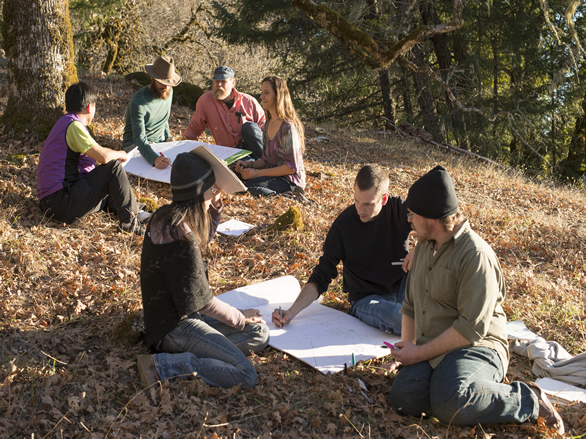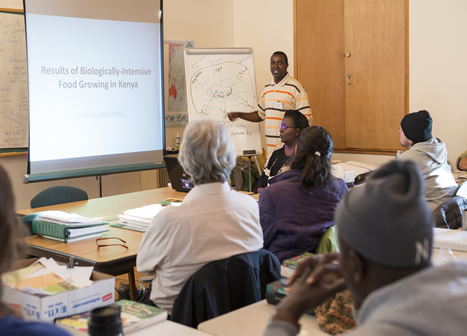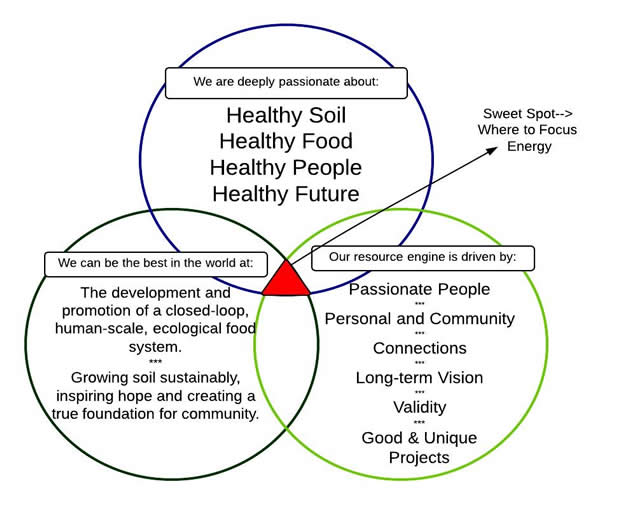A Special Two-Week Farmer Course
Workshop participants brainstorm aspects of the 10-year plan. In early January, Ecology Action sponsored and hosted a unique Two-Week Farmer Course, with classes taught by Master GROW BIOINTENSIVE Teachers from the US, Latin America and Africa. Some participants also came from Asia and Europe. The purpose of this course was to create a new online education program, available worldwide, to provide resources and hope to counteract the challenges overtaking the world so quickly. Many are accepting that the long-forecasted world of the future is with us now. Our food supply chain has become dependent on large-scale, industrialized, chemical-based agriculture. Soil, water and air are polluted; soil has become depleted of organic matter and nutrients; and the global water supply is rapidly diminishing. Climate change is creating adverse conditions for food production worldwide. Because of the many barriers facing people who would like to farm in a more holistic way, the number of people actually farming has greatly decreased. As the momentum of these challenges continues to increase, the global food supply—and the billions of people who depend on it—are at risk. EA gathered together six Master Teachers in GROW BIOINTENSIVE and other related topics, who among them represent 125 years of experience using and teaching the GROW BIOINTENSIVE method. Because each teacher has been working in a diverse set of personal, cultural, geographical and social circumstances, their different emphases, teaching style and expertise wove a rich multi-dimensional picture of the Biointensive method and the resources it offers for a more sustainable small-scale farming system. The participants were inspired by what they learned and the way it was presented. (See the related article "Real Solutions to Real Problems.") The Master Teachers were John Jeavons, Director of Ecology Action for over 42 years, whose leadership has led to the development of GROW BIOINTENSIVE; Steve Moore, long-time farmer, GB farmer and professor of AgroEcology at Elon University in North Carolina; Juan Manuel Martinez, Director of ECOPOL in Mexico, who has spread GB throughout Latin America; Samuel Nderitu and Peris Wanjiru, founders and co-directors of G-BIACK in Kenya, who have taught thousands of farmers and other people, from both Kenya and other countries; and John Beeby, former EA staff person who is an expert in Biointensive agriculture and sustainability as well as being EA's main soil fertility advisor. They were supported by EA staff Eric Buteyn, Rachel Britten and Jake Blehm, Juan Manuel's assistant Patricia Mayagoitia, and Jed Diamond, an internationally respected health-care practitioner. The whole two-week course was filmed by a team of professional videographers, whose most recent documentary was "Fall and Winter." The footage will be turned into an online seminar series and translated into as many languages as possible to increase access to the information worldwide.
Above: Lecturers John Jeavons and Steve Moore prepare to give a presentation.
Samuel Nderitu of G-BIACK discussing GB results in Kenya. In the audience you can see Peris Nderitu (Samuel's wife and co-founder of G-BIACK) in front of him, Juan Manuel of ECOPOL in white shirt with back turned, and Patricia Mayagoita of ECOPOL sitting next to Juan Manuel. Rachel Britten led a brainstorming session each day to map out the future of Ecology Action. The Farmer Course took place at Ecology Action's beautiful library, where huge windows let in abundant light and where there is a large space for teaching. GROW BIOINTENSIVE's most experienced and inspiring teachers mixed with a handful of brand new students lucky enough to participate in this historic course—each providing their own special exuberance and innovation based on their individual histories and on-the-ground experience. A film crew was present to capture the best of the best GROW BIOINTENSIVE teachers available, presenting topics ranging from the current world situation to integrated pest management, leadership, and tool making. Giant cameras filled two corners of the room, but did not alter the heart of the place. This teaching zone, like the many that have preceded it, captures a particular kind of student—those willing to acknowledge the realities of global challenges and still approach active solutions to these challenges with not just hope, but joy. The cast presented a once-in-a-lifetime opportunity for brainstorming the future direction of Ecology Action, balancing respect for the old with excitement for the new. With such a unique opportunity, the question was how to approach a "directive-brainstorm" for this diverse, multi-faceted organization. The goal was not to create a list of "next steps" of projects for GROW BIOINTENSIVE to embark on. Instead, the objective was to provide a decision-making framework that simplified GB's goals, mission, and strengths. This simplification would ideally allow those working with the method to make directed, clear choices—in a variety of situations—based on the framework. Jim Collins' book, Good to Great, provided me with inspiration for this type of decision-making process. His book, originally written for the corporate world, tracks several companies that shifted from being good companies to becoming great companies. The ultimate question, of course, is: What were the active steps these companies took to propel themselves from good to great status? The answer to this question, as assembled by Collins and his research team, is as relevant to non-profits as it is to the corporate world. Though the book offers several suggestions, one stood out for me as a particularly useful tool for the work of Ecology Action: find what you do very well and do it as well as you possibly can. Collins developed a diagram to help organizations figure out a personalized approach. The following figure was the result of our 10 hours of brainstorming. The triangle where all three circles intersect is where all of the energy of an organization should be directed.
Having established this EA-specific diagram, we practiced applying it to some ideas participants had. One important lesson was acknowledging that when things important to our mission did not fall in the central triangle of the three overlapping circles, a useful tool was to seek out other non-profit organizations more directly geared toward the type of work we valued but which did not fit our diagram. Working with partners to accomplish large-scale goals, instead of directing our own limited resources (people and financial) to things outside the realm of our expertise, represented an ideal way to maximize the benefits of a non-profit "ecosystem" in which many nonprofits work efficiently together to create a better world. This coming month, the staff in Mendocino County will be meeting together to further apply this concept to ideas generated about future projects for the Mendocino sites and beyond.
top | Newsletter Home | Article Index | Archive
|






